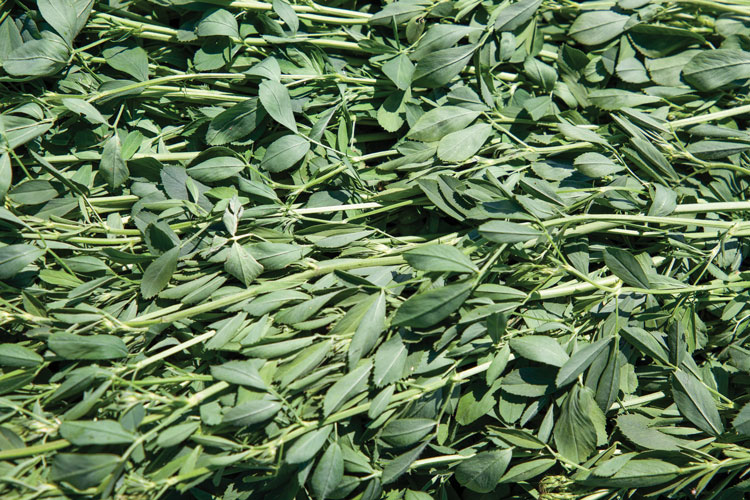
When teaching others to review and interpret forage analyses, the first number that I tend to focus on is fiber content. In dairy or beef nutrition, our world often centers around fiber. We’ve covered fiber extensively over the past several years and will continue to do so in the future. In my opinion, this structural carbohydrate is the single most important nutrient in forage.
Fiber affects dairy and beef cattle in different ways. Fiber in the ration partly determines how much feed the cattle can consume, impacts rumen health, and also affects diet energy density. Expanding on the energy impact, it’s fascinating to consider that fiber, starch, and sugar each contain the same calorie potential per pound. The key word in this sentence is potential.
With fiber, the potential is never realized compared with grains because only half of the fiber calories are unlocked by dairy or beef cattle due to complex lignification. Further, the range in calories available from fiber is immense relative to all other forage components. Hence, fiber has been tied into every single forage quality index including leaf-to-stem ratio. This will make sense as we describe what comprises leaves and stems.
As alfalfa and grass plants emerge and grow, the leaves absorb and convert the sunlight’s energy. This energy is harnessed through chlorophyll attached to protein and used to build sugars from carbon dioxide that’s been absorbed from the air. Leaves are the power plant for the growing alfalfa or grass. Chlorophyll is linked to protein and the photosynthetic process yields sugar. The sugar is the fuel that then drives growth or storage in plant reserves.
The stems provide the structure for the plants, holding up the leaves. As mentioned before, fiber is a structural carbohydrate and a critical component of the stem structure. Think of fiber like the framing and the foundation within the house, binding the structure together.
This science lesson is relevant because leaves are rich in protein and sugar and the stems are full of fiber. This brings us back to the point made earlier — fiber is tied into every forage quality measure, including leaf-to-stem ratio. However, the value of a leaf percentage measure is likely beyond a nutritional interpretation.
Goes beyond nutrition
Leaf-to-stem ratio, or leaf percentage, has been introduced in the past decade as a forage quality index. Today’s commercial feed analysis laboratories offer this measure through a partner. The utility around the measure has been interesting, with the University of Wisconsin’s Dan Undersander helping generate a bit of discussion or interest in this commercial feed analysis measure. Beyond popular press and conference proceedings, there is also a bit of published literature to reference for added insight and context.
The published literature archives contain a few articles discussing near-infrared reflectance spectroscopy (NIRS) calibration for leaf percentage or leaf-to-stem ratio. The earliest published study I could find dates back to 1988. As described above, I often view forage analysis through a nutritionist lens.
When I field questions about interpreting leaf-to-stem ratio or the leaf percentage, I’ve often responded that simple protein and fiber measures are just as valuable in determining forage nutritive quality. Higher protein feed will contain a greater leaf-to-stem ratio, whereas higher fiber alfalfa will be more stemmy. However, this 1988 article opened my mind to analysis applications outside of nutrition and discussed the impact leaf percentage has on the plant-animal interface within pastures.
Grazing ruminants actively select and sort for leaves; hence, higher leaf percentages in the paddock equate to greater gains or performance. Leaf percentage insight can also help producers manage paddocks to find agronomic practices that yield higher leaf percentages. Beyond grazing, leaf retention during harvest is imperative to maintaining quality from the field to storage. Whether dry hay or for silage, leaf shatter and loss is a substantial detractor from forage quality and value.
An informative measure
Undersander has stressed the leaf percentage measure to assess impact associated with different agronomic amendments or harvest management strategies. In general, more leaves are desirable and the leaf-to-stem ratio measure is informative to assess leaf losses from substandard fertility, disease or insect pressure, or harvest management issues.
In the early 2000s, another study was published evaluating NIRS potential for measuring leaf concentration and mineral or ash content. This study again spoke to applications beyond nutrition such as biofuel generation or alfalfa pelleting quality, but more importantly, it agreed with the 1988 reference in that commercial NIRS analysis is fully capable of measuring the leaf percentage.
While traditional forage quality measures like protein or fiber continue to be valuable for diet formulation and feeding, checking your forage leaf percentage or leaf-to-stem ratio can prove informative for agronomic, grazing, or harvest management practices.
This article appeared in the November 2023 issue of Hay & Forage Grower on page 21.
Not a subscriber? Click to get the print magazine.

